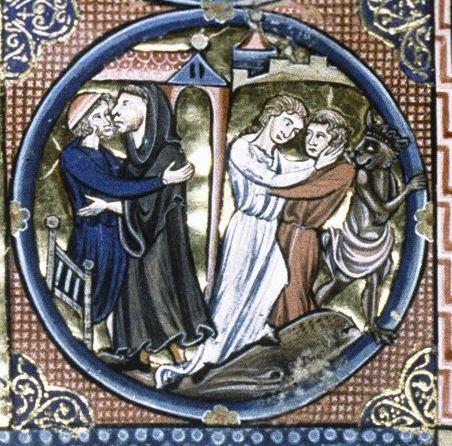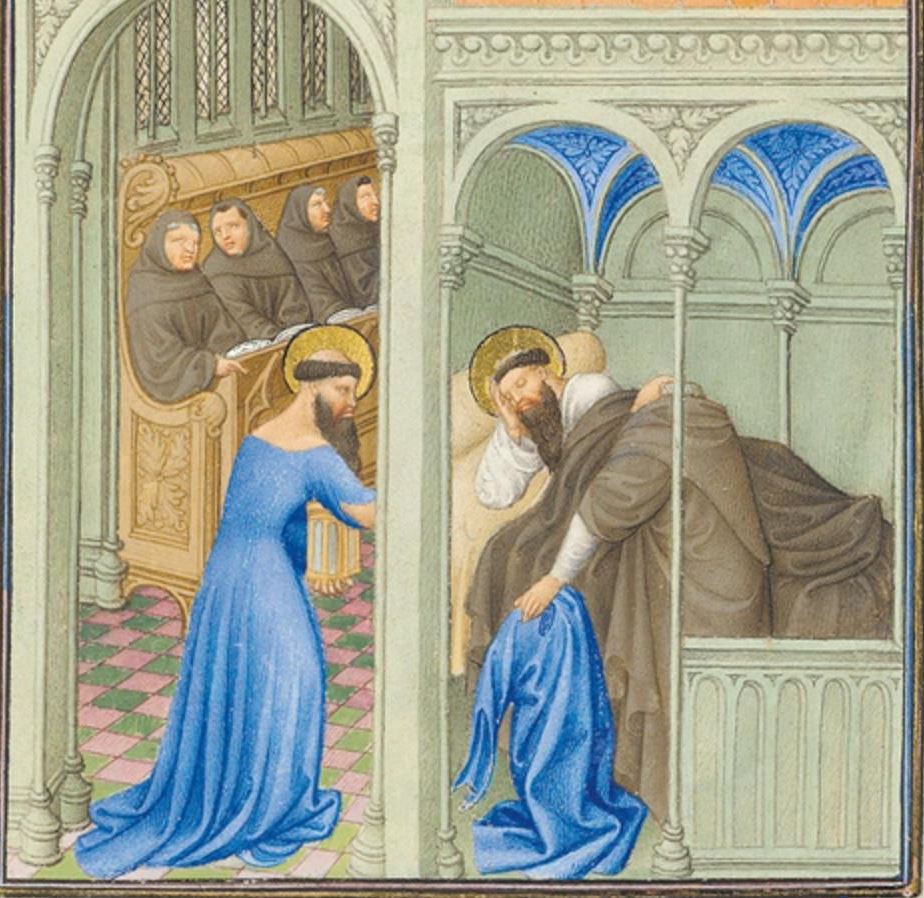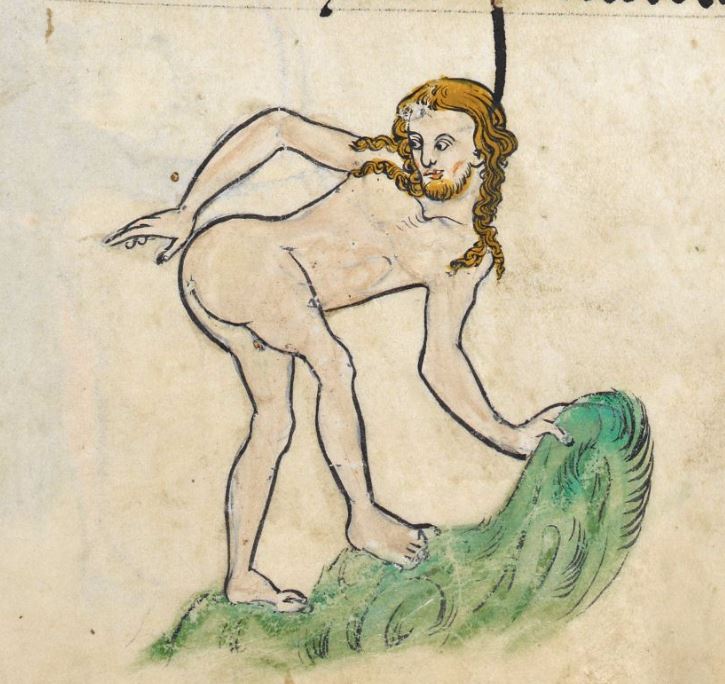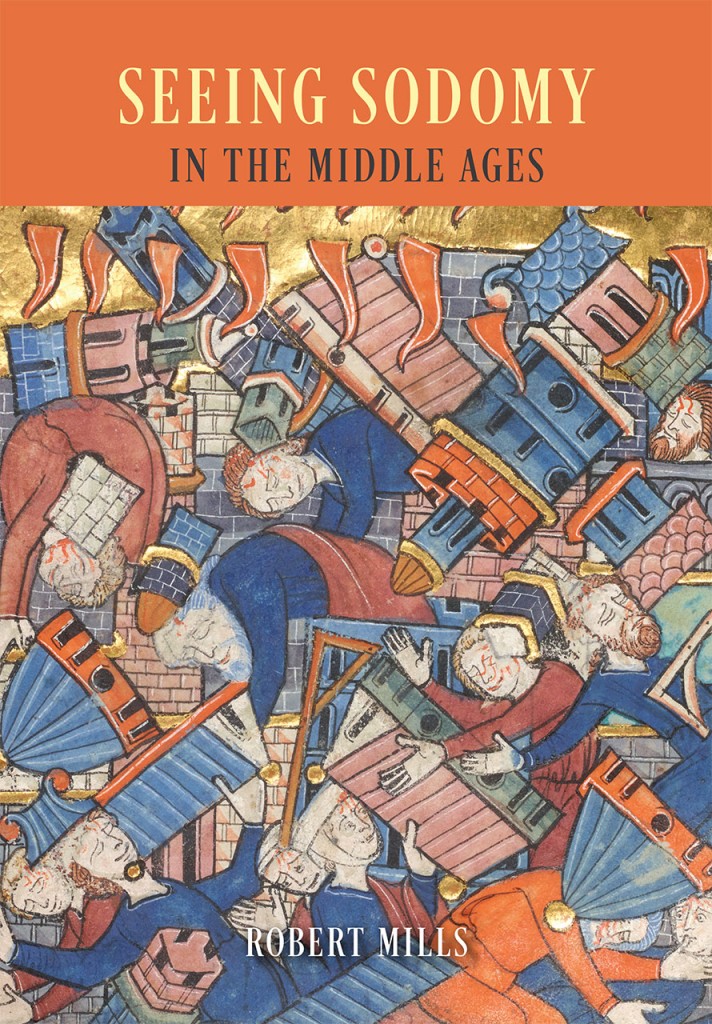Interview by Rachel Moss
Seeing Sodomy in the Middle Ages explores the variety of strategies developed by medieval artists and writers to render sodomy visible. The author Robert Mills argues that we need to take account of the role played by translation—whether visual, verbal or cultural—in endowing sodomy with a pictorial or textual form. Mills also considers the extent to which medieval materials can be re-visioned in light of twenty-first-century categories of thought. Arguing against the view that anachronism inevitably produces a distorted picture of the past, he advocates instead a flexible approach to questions of terminology—one in which fidelity to an authentically ‘medieval’ vocabulary doesn’t constitute the only possible framework for understanding images of gender and sexuality in the period. Focusing on a wide array of sources, including visual depictions of sodomites in illuminated Bibles, motifs of gender transformation as envisioned by medieval artists and commentators on Ovid, and imagery and texts associated with religious houses and other enclosed spaces, the book builds a picture of sodomy’s rich multimedia presence in the Middle Ages.
Rachel Moss: For the reader unfamiliar with your wider work, seeing a book titled Seeing Sodomy in the Middle Ages might lead them to expect a monograph that is, if not exclusively concerned with particular sex acts, at least one which is preoccupied by sex acts between men. Yet Seeing Sodomy explicitly rejects a reading of sodomy and by extension of ‘queer’ that is a ‘byword in historical research for what previously went under the sign of homosexuality… [and which] has sometimes been accompanied by an overriding emphasis on male experience’. Can you talk about the process by which you came to use sodomy as a category of analysis and a framing device for an enormously wide-ranging discussion of identities, practices and expectations that could be read as ‘queer’?
Robert Mills: I’ve been thinking about the category of sodomy for a long time. My doctoral research, which became my first book Suspended Animation: Pain, Pleasure and Punishment in Medieval Culture, led me to a series of Last Judgment paintings depicting sinners being skewered on spits by demons and roasted in hell. In one such image, a fresco in the collegiate church of San Gimignano, Italy, the spit-roasted figure is labelled ‘sotomitto’—a play on the word for sodomite. I became fascinated with the strategies adopted by artists to render sodomy visible. In this particular instance, the sinner’s punishment clearly alludes to acts of anal penetration. Italy was a region where, in the fourteenth and fifteenth centuries, sodomitical crimes were policed aggressively by secular authorities in urban centres such as Florence. So in my initial forays into the topic, I connected the depiction of sodomy in religious art with its emergence as a judicial category. I even speculated that the didactic aims of such images had the potential to backfire, ‘fuelling the imaginations of a cluster of medieval sodomites and queers’. After all, the San Gimignano scene arguably generates quite a clear picture of what sodomites get up to sexually.
In other contexts, though, the meanings of sodomy are much less precise. Initially, sodomy was a theological concept, which served only intermittently to refer to a clear variety of sexual activity. The Latin noun sodomia derives from the name of the city of Sodom, as described in the biblical book of Genesis. But the Bible is notoriously vague about the reasons for the city’s destruction. Some medieval commentators, building on such references, referred also to the ‘sin against nature’ or the ‘unmentionable vice’. But these smokescreens mean that it’s not always possible to work out exactly what is being condemned. In a document containing probably the earliest recorded use of sodomia, the sodomite sin comprises any unnatural act committed by either man or woman that results in a loss of semen. That could potentially apply to quite a number of sex acts!
Today in Britain the definition of sodomy has substantially narrowed: the word tends to be used almost exclusively to refer to anal intercourse, usually between males. Anal sex was certainly sometimes included within medieval understandings, as the San Gimignano painting powerfully demonstrates; but in the book I deliberately hold back on discussing the act now most commonly associated with sodomy until the very last chapter. This is because the images and texts I encountered in my research also refer to a much wider range of practices and behaviours—including some that don’t register as sexual. Chapter 1, discussing a group of richly illustrated Bibles, shows just how widely the concept travels, even in interpretations of the Genesis story of Sodom. It could apply to women as well as men, or be used to stigmatise figures identified as Jews, Saracens or heretics. It could even be rendered visible by analogy with an outbreak of haemorrhoids.
I’ve also discussed sodomy’s confusions in other publications, notably in my contribution to A Gay History of Britain. There I focus especially on textual references to sodomy. The British Isles are an interesting case study because, unlike some other parts of Europe, there were no secular laws specifically proscribing sodomitic crimes throughout the Middle Ages. Very occasionally we catch a glimpse of alleged acts of unnatural sex in church court records, or in documents recording inspections of religious houses. But sodomy is conspicuously absent in records of temporal justice. In my section of A Gay History of Britain I also consider alternative frameworks for representing intimacy between males, notably discourses of friendship and wed brotherhood. Although same-sex friendships were occasionally characterised as sodomitic, they were also often culturally sanctioned and even celebrated. Viewing this material through the prism of categories such as ‘gay’ or ‘homosexual’ may produce visions of a culture simultaneously tolerant and intolerant of homoeroticism, when in fact people at the time were probably working with very different frameworks.
In the course of researching these previous publications, however, I became frustrated with the limits imposed by some of our current ways of seeing and doing history. The interest in books such as A Gay History of Britain has partly been driven, I suspect, by the emergence of discrete publishing markets, which tend to organise histories of sexuality along gendered as well as national lines. Lesbians, it’s assumed, will be interested primarily in reading about their female forebears, while individuals who don’t fall neatly into categories such as ‘lesbian’ or ‘gay’ are left to forage in the footnotes for references to lives that resonate with their own experiences of queerness.
Also, it’s often assumed that histories of female homoeroticism and female masculinity form a separate field of study from those of their male counterparts. As such, research on medieval sexualities has itself tended to divide up along gender lines. While there’s certainly still much to be learned from gender-specific analyses of medieval sexualities, in Seeing Sodomy I deliberately set out to highlight the benefits of a gender-comparative approach to the subject. Sometimes, indeed, this requires that we go beyond sodomy. The word ‘sodomy’ works as a convenient shorthand for communicating the book’s subject matter, but medieval writers often made use of alternative terminology, notably when discussing female masculinity and sex between women. And for all the perceived invisibility of lesbianism in the period, there are moments when female homoeroticism really does enter the field of vision. Given the explicitly gendered language that is so often applied to sodomy and its cognates, it is hard to get away from women’s implication in these categories, even when the targets of anti-sodomitical rhetoric are ostensibly male.

Moss: As someone who tries to occupy an interdisciplinary space with my own work, something I particularly enjoyed about Seeing Sodomy is its integrated use of visual and textual sources. You’re perhaps especially well placed to do this, having been both a Lecturer in English and a Reader in Medieval Art, but have there been any challenges posed by the different critical expectations of gender/sexuality studies in these two fields?
Mills: I’ve always felt that I’ve been at a distinct advantage when it comes to developing cross-disciplinary approaches. Part of this has to do with the way I was trained. I was lucky to have the opportunity to study for a BA in Medieval Studies, so I tend to think of myself as a medievalist first, and as an art historian and literary scholar second.
I didn’t experience any major disciplinary divisions when it came to researching Seeing Sodomy. Although today’s queer studies is a very broad church, when the field first emerged in the 1990s some of the most significant voices were literary scholars. Art history arguably came later to the ‘queer theory’ table compared with other disciplines in the humanities, but scholars such as Michael Camille (whose was himself profoundly interested in the relationship between text and image) developed analyses of queerness in medieval visual culture that have provided an impetus for my own work.
The bigger issue, I think, concerns the perceived distinction between gender and sexuality in the field of vision. It’s often assumed that gender is a characteristic written visibly on the body, through outward signs such as clothing, gesture or comportment. Conversely sexuality is perceived as the inner secret that gender openly declares. If a man wears the visual signifiers or performs the bodily style of a gender that doesn’t conform to his anatomical sex (as in the image of Saint Jerome discussed in the opening pages of Seeing Sodomy), a modern viewer might until very recently—and possibly still—have cause to assume that his gender-transgressive appearance registers an underlying disposition towards sex with men.
Think of the scene in Mel Gibson’s Braveheart (1995) where Prince Edward is depicted wearing makeup, dressed in flamboyant clothing and admiring himself in a mirror while cavorting with a group of effete young men. After he became king of England, Edward was indeed sometimes accused of sodomitical leanings by commentators looking back on his reign. But in Gibson’s film (which drew accusations of homophobia at the time of its release) Edward’s gendered appearance functions as a visual code for homosexuality. Seeing Sodomy asks when and how such configurations operated in the Middle Ages. Were modes of gendered presentation such as cross-dressing always a byword for something sexual? It’s not possible to answer this question fully without addressing issues of the visual. Situating my project at the interface between text and image allowed me to take a long, hard look at how motifs of vision have contributed to the formation of those categories we today call gender and sexuality.

Moss: Who defined sodomites, and how were they meant to be recognised? In short: who was a sodomite in the Middle Ages?
Mills: That’s a big question. Actually, it’s the question around which the book is organised. How do you know a medieval sodomite when you see one? ‘He’ might turn out to be a ‘she’. Or ‘she’ may well be posing as a ‘he’. This is what clerics such as Alan of Lille, Peter Damian and Peter the Chanter say about the individuals they accuse of indulging in sodomitic practices. In legal situations, too, homoeroticism was often perceived as resulting in cross-gendered performances or in a wholesale ‘inversion’ of the grammar of sex. Such frameworks are less prominent in visual images than they are in texts. But medieval artworks depicting acts of cross-dressing, gender transformation or sex change do exist.
Equally, while some figures tarnished with the brush of sodomy emerge with their gender identities intact, they might also be condemned for some other aspect of their behaviour. After Orpheus lost Eurydice in the underworld a second time he was, according to Ovid, the ‘first’ among the people of Thrace ‘to transfer love to tender males’. Yet in one of several interpretations appended to a medieval reworking of the story, the mythical hero’s desire for males becomes a metaphor for spiritual ascent: his turn away from ‘feminine’ love to ‘masculine’ virtue is seen as echoing God’s penchant for chaste young male religious. In other texts, however, Orpheus is also condemned for corrupting adolescents with his ‘evil’ doctrine. This is taken to an extreme in a famous drawing by Albrecht Dürer, The Death of Orpheus, which labels the dying protagonist ‘the first sodomite’. While Orpheus receives his deathblows from a pair of resentful women, a chubby male child exits stage right, casting a backward glance at his corrupted teacher. In this way Dürer effectively infantilises the ‘tender males’ in Ovid’s story.
This represents another way in which sodomites were rendered visible in medieval art: they could be implicated in age-differentiated sexual relations, or even in scenes of child abuse. Clerics and monks were especially susceptible to accusations that they were abusing younger males in their charge. Chapter 4 in the book is devoted to imagery used to discipline the desires of cloistered monks. The classical myth of Ganymede was often transformed by medieval writers and artists into a form that resonated with contemporary moral teachings, so that Ganymede too could be presented as a victim of sodomitical passion. But as with the Orpheus narrative, Ganymede’s abduction was also sometimes harnessed as a figure for divine rapture. Clerical commentators developed some ingenious strategies for bringing Ovid’s stories into the purview of Christian symbolism.
Moss: Is identification as a sodomite always something that is done to someone, or do you think ‘sodomite’ could have been a term of self-identification?
Mills: Sodomy’s rhetorical colouring defies attempts to gain direct access to the real voices of medieval sodomites. The San Gimignano sodomite wears a label on his head identifying him as such, but this functions as a badge of shame not pride. So no, I’ve not encountered any instances of medieval people actually self-identifying as sodomites.
But my argument is that translation sometimes provided artists and writers with a mechanism for contemplating acts of sexual and gender dissidence, particularly when those acts were safely located in myth or in the distant past. Sodomy itself is fundamentally a metaphor, a translation. The concept is based on a proper noun derived from an obscure biblical text, which is used to talk about something that’s often quite unrelated. What that ‘something’ is shifts and morphs with each text in which it appears, each context in which it’s deployed. Through acts of translation, then, some individuals may have found a means of re-configuring their own gender or sexual identities, perhaps in more positive terms. One example I discuss in the book is the fifteenth-century poet and intellectual Christine de Pizan, who discovers in Ovid’s story of Iphis, which concludes with a miraculous sex change, a parallel with the author’s own transformation into a ‘natural man’. Significantly, however, Christine desexualises the Ovidian narrative, eliminating much of its (homo)erotic potential. While wilful identification as a sodomite is never on the cards, Christine describes an experience of sex transformation that arguably parallels more recent expressions of transgender.
Moss: The use of words like ‘homosexual’, ‘heterosexual, and ‘transgender’ have been the subject of exhaustive (and sometimes exhausting!) discussion by historians—whether these categories of analysis are appropriate in the past, what other words we might use instead, whether homosexual ‘identities’ exist if past societies lack our modern vocabularies, etc. In your conclusion, you make a strong case for being wary of developing a ‘new philology’ in the history of sexuality, of resisting entirely anachronistic use of modern categories of identity and activity. Can you explain why?
Mills: There are several reasons. First, scholars have sometimes applied (often probably unwittingly) a double standard in the history of sexuality. Terms such as ‘heterosexuality’ are treated as legit, while any mention of homosexual identity risks courting the accusation that it’s anachronistic. The problem here is that articulations of a time ‘before homosexuality’ leave in place notions of modernity as a conceptual unity, fully at ease with its homogenised notions of gay identity. This binds researchers into false narratives of temporal progression and cultural uniformity, when the modern world itself has no commonly agreed criteria for designating who or what is homosexual in a given context. For all the cultural dominance of the hetero/homo binary in modern Britain, in practice we’ve learned to accommodate a fair amount of fuzziness in the application of these terms.
Also, I don’t think historical work can eliminate anachronism completely. Any dialogue with the past necessarily performs the work of translation. ‘Medieval’ is itself a completely anachronistic term when applied to the so-called ‘Middle Ages’. The very terms we use to identify this roughly 1000-year epoch, which continue to carry so much negative baggage in the present, mean that medievalists are perhaps more alert than most to the pitfalls of translating the past into the languages of the present. The writers discussed in the book would never have thought of themselves as ‘medieval’. There’s nothing wrong with excavating the specific meanings attached to a word or idea in the distant past. Indeed these investigations are often crucial: if the past is simply used to hold up a perfect mirror to the present then there isn’t much need for history. But I worry that scholars who propose a rigorously philological approach are also sometimes throwing the baby out with the bathwater.
Indeed, my argument in Seeing Sodomy is that a careful and measured engagement with post-medieval terminology can sometimes be enormously productive. One phrase often rejected by medievalists is ‘sexual orientation’. This is seen as importing a modern, psychologised idea of sexual identity into the period’s encounters with sex. In fact, as discussed in the book’s fifth and final chapter, virgins in the Middle Ages were believed to possess many of the qualities that today fall under the heading of sexual orientation. Virginity was actively promoted as a lifestyle; its practitioners were distinguished morally, socially and even physiologically from non-chaste subjects; the desires of virgins were filtered through a directional vocabulary, which literally oriented them towards God. By contrast sodomites were characterised as thoroughly disoriented individuals, directing their passions along a demonic path. So instead of discarding modern terminology completely (which in any case would be impossible), I suggest that we pose the question of the orientation in ‘sexual orientation’ as a means of comprehending the directional nature of desire in medieval thought.

Moss: For me, the most important chapter in the book is the second, on ‘Transgender Time’; as you point out, it is ‘only rarely that scholars of the Middle Ages deploy transgender as a category of analysis’. You then devote several pages to refining but also justifying your use of the term ‘transgender’. Given it’s clear that medieval clerics at least were more troubled by disruption of gender roles than by homosexual sex acts per se, why do you think that there has been such resistance amongst medievalists to considering transgender experience?
Mills: Medievalists can be very vocal about the perils of anachronism, so perhaps it’s little wonder that they’ve been somewhat slow on the uptake when it comes to contributing a medieval chapter to the history of transgender. But medievalists haven’t resisted engaging with transgender experience per se: they’ve simply been using other frameworks. There are many studies, for example, devoted to the lives of cross-dressing saints. Recently there’s also been a proliferation of work on hermaphrodites and other androgynous individuals in pre-modernity. To date scholars working on sodomy have tended to view the gendered ramifications of the category as pertaining principally to what we now call homosexuality. But reconsidered in light of the current vogue for separating out transgender identities from those of gay, lesbian or bisexual people (as in the popular LGBT or LGBTI acronyms), this material might equally be perceived as coming under the heading of transgender. In Seeing Sodomy, I investigate the potential benefits of refracting the Middle Ages through a transgendered lens. Crucially, though, I also consider what gets lost when we adopt this particular perspective as our interpretive framework.
Moss: You articulate a potential tension between recognising gay and lesbian lives and recording transgender people. So, for instance, acts between two women being read as lesbian can overwrite the possibility that the ‘masculine’ behaviour of one party is a mark of gender status rather than of same-sex desire; but reading a masculine-performing woman as a trans man could relegate their ‘partner to the sidelines’. How do you find the category of sodomy useful in managing this tension?
Mills: Yes, I do think there’s potentially a tension here. The Iphis narrative discussed in chapter 2 has the capacity to generate both lesbian and transgender readings; but each retelling differs markedly when it comes to deciding where the precise emphasis lies. In some accounts, Ovid’s story about a masculine-performing woman who becomes a man provided writers with an excuse to contemplate the prospect of a sexually fulfilling relationship between two women. But the writers are quick to qualify their musings with the observation that this all happened a very long time ago. Other versions prefer to highlight the transgender content at the expense of homoerotic meanings: I’ve already mentioned Christine de Pizan’s desexualised reworking. So it’s clear that medieval readers themselves were capable of imagining a spectrum of possibilities.
The phenomenon of sodomy can be useful here because it often requires that we think about gender and sexuality together. Instead of pertaining wholly to one or the other category, sodomy challenges us to think across the conceptual, political and institutional divisions that shape current understandings of the relationship between (trans)gender and (homo)sexuality. Although I do think medieval people were capable of separating gender and sexuality out in certain contexts (Christine’s meditation on sex change is a case in point), it’s worth emphasising that the emergence of a clear conceptual distinction between gender identity and what’s come to be known as ‘sexuality’ in Western cultures is relatively recent. Even into the second half of the twentieth century, people who engaged in homoerotic behaviour didn’t necessarily have need for a separate notion of homosexuality. Today this is still the case in some parts of the world. Even in Britain there are people who engage in homosexual sex without seeing themselves as ‘gay’, while the troubling of prevailing gender codes or power dynamics can still be an important ingredient in the formation of modern queer identities.
As I’ve said before, though, sodomy wasn’t consistently the word of choice for medieval commentators, especially where women were concerned. In judicial settings, masculine-performing women were very occasionally accused of sodomy or named as ‘sodomites’. Although Christian thinkers had concerned themselves with female same-sex practices since the early Middle Ages, theologians only began applying sodomia to women from the mid-1200s. Usually the texts in question used other terminology, notably focusing on the ‘unnatural’ and fraudulent consequences of sexual relations between women and/or gender trouble. This is where I find it useful to imagine what I call a ‘Middle Ages of coexisting possibilities’, situated somewhere between ‘lesbian’ and ‘transgender’. Sodomy is one term that potentially cuts across the gender/sexuality distinction, while some modern thinkers—myself included—have also found ‘queer’ helpful in negotiating this fault line.
Moss: One of the motivating impulses of queer history is, as you discuss, tracing ‘experiences of violence and marginalisation from past to present.’ You use Lot’s wife and Orpheus as poignant motifs for this looking backward; but I wondered if these icons of the backward glance could also be used for a more positive reading of a queer past. In what ways does seeing sodomy in the Middle Ages give us a chance to reclaim Eurydice rather than being turned into a pillar of salt; of seeing positive relationships and experiences rather than only prohibition and loss?
Mills: Yes, absolutely. Orpheus can and has been appropriated as a model for a more enabling encounter with the queer past. Kaja Silverman’s Flesh of My Flesh discovers in the Orpheus myth a message about the power of analogy: Orpheus’s backward glance at Eurydice sets in motion a chain of events that returns the couple to a mode of relationality before the binary of gender. When, in Ovid’s version of the story, Orpheus himself dies and becomes reunited with Eurydice, he finally acknowledges her equality. In Feeling Backward, Heather Love has also made a compelling argument for appropriating figures such as Orpheus and Lot’s wife as possible ‘icons’ for what Love characterises as the pull of backwardness in queer historical work.
With one or two exceptions, though, medieval responses to both these stories seem extremely negative—at least from the perspective of modern readers and viewers casting a queer eye on the period. In manuscript illuminations Lot’s wife is consistently presented as a loser, the very embodiment of eternal regret. Conversely Orpheus’s own queer moment tends to be sidelined in favour of depictions representing Orpheus with Eurydice. Of course, to the original audiences for these images, the latter would have resonated positively. But it was interpreted less as a story about sexual equality and the power of analogy than as a narrative establishing the primacy of bonds between male and female. Erotic relations between men and women thus received a striking visual endorsement in these illustrations, which served to differentiate Orpheus’s and Eurydice’s union from the ‘derivative’ sodomitical activities in which Orpheus had previously dabbled.

Moss: Many of the sources you use in your book are ‘elite’ texts, in that they (words and images alike) are produced and read primarily by educated audiences. Do you think that the often highly intellectualised understandings of sodomy you present were translated into, or influenced by, a wider discourse on gender and sexuality?
Mills: That’s a good point. The moralised Bibles I discuss in chapter 1 were especially elite productions, since they were produced for members of the French royal family. Consequently it’s likely that some of these books were hardly ever read. Indeed this may explain why sodomy was discussed relatively openly within the confines of the Bibles’ pages: there was less risk that the depictions contained within would be disseminated to a wider audience. In the closing section of this chapter I speculate on the potential impact of the manuscripts’ depictions of sodomy on their original viewers, noting, for instance, that laws against sodomy were instituted during the reigns of some of the books’ original owners. But it’s not possible to establish a direct connection here.
The presence of a more obvious interface between ‘elite’ and ‘popular’ conceptions of gender and sexuality comes through in some of the material explored in chapter 5. Here I discuss an eclectic range of imagery depicting acts of arse-baring, arse-licking and anal penetration. On the surface this probably all sounds highly sodomitical to a modern ear. But I show how rectal exposure also bore other meanings too, notably as an apotropaic device or as a defamatory insult. Here we’re probably witnessing a more widely disseminated set of meanings. Still, though, several of the images analysed appear in books to which access would have been severely restricted. It’s only in imagery developed for public settings, such as a remarkable sculpted panel depicting infernal punishments on the west front of Lincoln Cathedral, that we catch a glimpse of what ordinary folk would have been confronted with when they saw sodomy.
Moss: And finally – at the end of the book you say you have been looking for ‘plural, conflicted worlds’, and that seeing sodomy ‘generates multiple lines of sight.’ What worlds do you hope you (or other scholars) might see with these new views? And why do they matter beyond the Middle Ages?
Mills: The book makes no claims to resolving all the contradictions and confusions that sodomy throws up for modern viewers. But I really hope it will inspire other researchers to pick up the gauntlet. I know of plenty more material that I could have included in the book. A 1993 restoration in the crypt of a church in Leonessa, Italy, revealed a series of Giottoesque frescoes, which include a painting of hell featuring another spit-roasted sinner labelled ‘Sodomito’. The church isn’t on the tourist trail and it’s always possible that more such artworks will turn up in future. And I only had time to mention briefly in a footnote a fabulous altar frontal, now in a museum in Paris, which features the legend of a cross-dressing saint: some scenes in the work register very queerly when considered from a transgender perspective. Much of the material discussed in the book is English, French, Italian or German in origin, but I’ve no doubt that further research will reveal even richer worlds of sodomitical imagining in other regions.
These multiple lines of sight matter beyond the Middle Ages because we’re still working out where we stand when it comes to doing and thinking gender and sexuality. Despite claims by some modern individuals to know exactly what it means to be ‘lesbian’, ‘gay’, ‘bisexual’ or ‘transgender’, we’re probably all familiar with situations when the definitional lines become a little hazy. Instead of attempting to resolve these issues by devising an evermore-refined taxonomic system, Seeing Sodomy suggests that we confront instead the simultaneous necessity and impossibility of translation. Our own current categories won’t describe us fully, any more than categories such as sodomy provide a transparent window onto the medieval past. Bringing past and present into a mutually informing dialogue is a better way to go.
 Robert Mills is Reader in Medieval Art at University College London. He specialises in late medieval art and literature, with a particular focus on issues of gender and sexuality. Before joining UCL in 2012, he was Senior Lecturer in English at King’s College London and Director of Queer@King’s. Mills is also author of Suspended Animation: Pain, Pleasure and Punishment in Medieval Culture (Reaktion, 2005), author with Matt Cook, Randolph Trumbach and H.G. Cocks of A Gay History of Britain: Love and Sex Between Men Since the Middle Ages (Greenwood, 2007), editor with Emma Campbell of Rethinking Medieval Translation: Ethics, Politics, Theory (D.S. Brewer, 2012) and Troubled Vision: Gender, Sexuality, and Sight in Medieval Text and Image (Palgrave, 2004), and editor with Bettina Bildhauer of The Monstrous Middle Ages (University of Wales, 2003).
Robert Mills is Reader in Medieval Art at University College London. He specialises in late medieval art and literature, with a particular focus on issues of gender and sexuality. Before joining UCL in 2012, he was Senior Lecturer in English at King’s College London and Director of Queer@King’s. Mills is also author of Suspended Animation: Pain, Pleasure and Punishment in Medieval Culture (Reaktion, 2005), author with Matt Cook, Randolph Trumbach and H.G. Cocks of A Gay History of Britain: Love and Sex Between Men Since the Middle Ages (Greenwood, 2007), editor with Emma Campbell of Rethinking Medieval Translation: Ethics, Politics, Theory (D.S. Brewer, 2012) and Troubled Vision: Gender, Sexuality, and Sight in Medieval Text and Image (Palgrave, 2004), and editor with Bettina Bildhauer of The Monstrous Middle Ages (University of Wales, 2003).
 Rachel Moss is a Leverhulme Early Career Fellow at the Faculty of History, University of Oxford. She has a PhD in Medieval Studies from the University of York and is the author of Fatherhood and its Representations in Middle English Texts (D.S. Brewer, 2013). She blogs on feminism, academic culture and medieval texts at menysnoweballes.wordpress.com and tweets @menysnoweballes.
Rachel Moss is a Leverhulme Early Career Fellow at the Faculty of History, University of Oxford. She has a PhD in Medieval Studies from the University of York and is the author of Fatherhood and its Representations in Middle English Texts (D.S. Brewer, 2013). She blogs on feminism, academic culture and medieval texts at menysnoweballes.wordpress.com and tweets @menysnoweballes.

NOTCHES: (re)marks on the history of sexuality is licensed under a Creative Commons Attribution-NonCommercial-NoDerivatives 4.0 International License.
Based on a work at www.notchesblog.com.
For permission to publish any NOTCHES post in whole or in part please contact the editors at NotchesBlog@gmail.com





